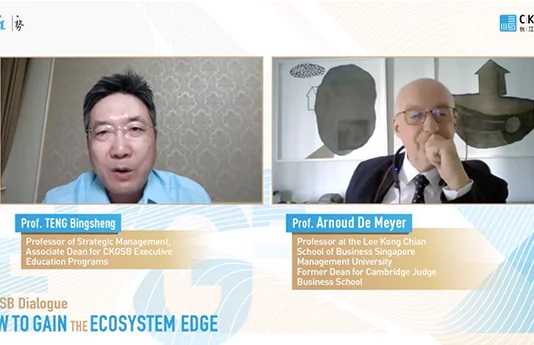This is a four-part series on storytelling. In the first and second article in the series, we looked at the case for storytelling as a sales and management tool and what the necessary ingredients are for a successful management or sales story. In the third and fourth articles, we will look at how better storytelling can help you in your career and how people are using storytelling analysis as a way to understand organizations better.
Part 3. Choosing the right story
Executives have long understood the business value of a ripping yarn.
Laurence Prusak, co-author of Storytelling in Organizations (2005), likes to tell a story about a presentation he once heard by Jack Welch, then the legendary CEO of GE, at Harvard Business School. Prusak, then a researcher at HBR, recalls that after the speech, someone asked Welch, what did you learn in school or graduate school that most helped you?
“And he said, well, I have trouble singling anything out, but then he thought for a minute, and he said, you know what’s the most useful talent I have? Now everyone must have thought, oh, he can envision the future – standard stuff you hear at Harvard – but he said that he was Irish and he grew up in a big family of storytellers. Everyone told stories; the Irish are big on that. He said, that’s the most useful thing I have. I can really tell a good story,” Prusak says.
“I remembered that – it stuck in my mind, and it happens to be true,” Prusak says. “He wasn’t smarter than anyone else, he wasn’t charismatic at all, but he could speak well, he could tell a good story.”
Welch’s assessment about the value of storytelling is far from unique. At some level, people have understood that storytelling can be a valuable skill. But as with so many other aspects of business, it’s only in the last 20 years or so that people have made a concerted attempt to professionalize it.
In recent years, dozens of books have been published on organizational storytelling, and almost as many consultancies launched: John Kratz, a Duluth, Minn.-based business storytelling consultant and trainer for Mike Bosworth Leadership, estimates that there are now 40 corporate storytelling consultancies in the US alone.
Each offers its own take on what makes a good story. Some firms help companies that adapt screenwriting techniques to tell corporate sagas. Others, such as Mike Bosworth Leadership, have a niche in tightly scripted sales stories. Still others teach executives how to lead with what Shawn Callahan, founder of Anecdote, a Melbourne, Australia consultancy, calls “the small s-story.”
Whatever the scale of your literary ambitions, however, some fundamental rules seem to apply:
Start with good material. People often have difficulty identifying what is and isn’t a story. Actually, according to Callahan, it’s simple: “A story is something that begins with a time-marker. As soon as you hear someone say, oh yeah, a couple of days ago, or, back in 2004, dot dot dot — if it begins with a time marker, there’s a good chance they’re about to tell you a story. Or if it’s not a time marker, it’s a place marker: We were in the boardroom and Bill walked in — story,” Callahan says. If they don’t mention a time or place right off, ask when, Callahan advises, not why.
A good story is also always visual. “A lot of people think stories are about words but they’re not, they’re really about pictures. It’s why we say things like, can you illustrate that for me? We use visual language when we talk about stories because that’s what makes a good story,” he says.
Subject matter can very, depending on the purpose. For sales stories, Mike Bosworth, the Orcas Island, Washington-based coach, advises designing stories that feature a client as a hero and your product as the verb that solved your hero’s problem.
For management stories, however, the story doesn’t need to be personal or even connected to your company, Callahan says. For example, he likes the story about how former IBM CEO Lou Gerstner cured the company of PowerPoint. “When he arrives, IBM was just overwhelmed with PowerPoint slides, they did every meeting with PowerPoint decks, or the equivalent at that time. His first meeting, there was a gaggle of executives all in their suits and ready to go with their PowerPoint slides and the head of hardware and integration stood up and started slide after slide and Gerstner got up and as quietly as he could, turned off the projector, and said, `how about we just talk about this?’” Callahan says.
“I always tell that as an example today of just the importance of being able to talk off the top of your head about a topic as opposed to having yet another slide deck. If you tell that story, it has a much bigger impact than just saying, guys, now maybe we shouldn’t use slide decks all the time, maybe we should just talk about it? You could say it that way, but it’s not half as impactful as telling a little Gerstner story attached to it.”
Don’t use the “S” word. “People learn about storytelling and then they start using the word story everywhere,” Callahan says. “They say, I just want to share a story with you. Well, in business, that’s like death. No one wants to hear the word story. But if you said instead of that, actually I’ve had a really interesting experience or I think I’ve seen this happen somewhere else before or some guys I knew had this experience, they love that. Experience is highly valued in business but story is not.”
Callahan suggests prefacing the point of your story at the beginning of the story. One reason you may want to cut to the chase is the fact that there often isn’t much time, at least in sales: Once upon a time, Bosworth says, B2B buyers would give a sales rep around 20 seconds to decide whether they were going to listen to them. Now, he says, that’s down to about 10 seconds.
Be sincere. John Sadowsky, an executive coach based in Switzerland and author of Email, Social Marketing and the Art of Storytelling (2011), says the key is to telling good stories about the company – or yourself, for that matter – is to make sure the story reflects your actual convictions. “I think you have to be clear about who you are and what you want to stand for.”
But finding that person isn’t always easy. “There is a real danger of drifting away from who you are and where you come from, what your core values are,” Sadowsky says.
When he begins work with individuals, Sadowsky asks them to reflect deeply about their past and present experiences. Over a period of months, he says, they explore their life journey in terms of their highs and lows, their sources of personal and professional satisfaction. At their most satisfying moments–when they had the most energy for what they were doing—what were the specific factors that made them feel fulfilled?
Eventually, Sadowsky says, they come to understand their best times in terms of the environments they were in, the events in their lives, the decisions they made, and the people around them. From there, they can see more clearly what is most important to them, and the origins of their core beliefs and values.
“If we spend some time plotting all of those things you see certain patterns of what makes these people happy, what makes them excited…. “From there, we try to figure out, well, okay, what made you who you are and…then use those things to say, this is who I am.’”
Occasionally, what makes the executive happy turns out to have nothing to do with the company that’s paying Sadowsky’s fee. This ought to be bad news for everyone concerned, but Sadowsky says the few times it’s happened the discovery actually works out better for everybody in the long run. “It’s never been a negative experience for the company or the person,” he says.
Tell the story you least want to tell. Others argue that telling the story that you least want to tell may make the most difference to your success. “Managers can become more effective leaders by sharing more of themselves,” says Dorie Clark, New York-based author of Reinventing You: Define Your Brand, Imagine Your Future, “… leaders who share their own story and vulnerabilities show employees that it’s OK to do the same.”
In a Harvard Business Review article that Clark co-authored with Christie Smith, managing principal of the Deloitte University Leadership Center for Inclusion, the two wrote about how Smith had avoided talking about her experience in the World Trade Center during the 9/11 terrorist attacks and the survivor’s guilt she felt afterward, but realized eventually that sharing those feelings made her colleagues feel safer to be open about their own lives.
This matters because many of us keep aspects of our private life hidden at work. In fact, 61% of all employees downplay some aspect of their identities out of fear of drawing unwanted attention or making others uncomfortable, according to their Deloitte study. This is a bad thing, the authors argue, because energy spent keeping something hidden is energy that’s not focused on the job. “When managers share openly, that unlocks employees’ potential at work because they can feel free to concentrate on doing their job, not ‘managing’ aspects of their identities,” Clark says.
When those stories focus on a person’s struggles with mental health, they can have an impact throughout the company and sometimes even an entire industry. One case in point: In 2011, Antonio Horta-Osorio, CEO of Lloyd’s Bank in the UK, made a public statement about his struggles with depression and a decision to take some time off to recover. His announcement triggered other executives to talk about their own health troubles, says Sir Cary Cooper, The 50th Anniversary Professor of Organizational Psychology and Health at the University of Manchester’s Alliance Manchester Business School.
“That storytelling enabled other people to admit that they had problems coping and that the job was having an impact on their health, particularly their mental health,” Cooper says. “I could provide Lloyds Bank or Barclays or any other bank with tons of data which shows what the pressures at work are costing that bank, and we have done, lots of people have shown the evidence, but nobody responded. That was facts. But the narrative, the individual coming up with his own personal story, had more of an impact that anything in the whole of the City, the financial sector, not just in his own company.”
“In a way, corporate storytelling is about bravery,” says Cooper. “It’s about saying something that you would not expect to hear…it’s got to be genuine, it’s got to be open, it’s got to be what you believe.”
Sometimes, sharing can even help a person stand out: R. Martin Chavez, Goldman Sach’s Chief Information Officer, has attracted a lot of press attention precisely because of a compelling personal story as a gay, Hispanic, recovering alcoholic in a firm once known for its conservatism.
As the unhappy but famous chanteuse Edith Piaf once advised, “Use your faults, use your defects; then you’re going to be a star.”

















